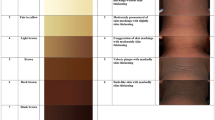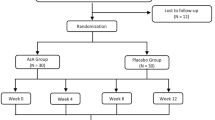Abstract
Acanthosis nigricans (AN) is a skin disorder with hyperpigmented and velvety plaques without a standardized treatment regimen. We aimed to compare the efficacy and safety profile of 0.025% and 0.05% tretinoin creams in managing AN. An 8-week, randomized double-blinded study was conducted in adults with AN. Participants were instructed to apply tretinoin cream on their posterior neck. Narrowband reflectance spectrophotometry was used to measure skin improvement through melanin (M) and erythema (E) indices at each follow-up visits at weeks 2, 4, and 8. Improvements in Acanthosis nigricans scoring chart (ANSC), investigator- and patient-global evaluation (IGE and PGE) and adverse cutaneous irritations were also scored. Both the 0.025% and 0.05% tretinoin creams were efficacious in acanthosis nigricans treatment with 17.1 ± 8.0% improvement and 18.4 ± 9.8% improvement after 8 weeks treatment by reflectance spectrophotometry measurement, respectively. There were generally no significant differences in efficacy, improvements in ANSC, IGE, and PGE scores, and local cutaneous irritations between the two groups. The 0.025% and 0.05% tretinoin demonstrate similar efficacy and safety profiles in the management of AN. Both concentrations are well tolerated with mild degree of local cutaneous irritation.


Similar content being viewed by others
Data availability
Available upon request.
Code availability
Not applicable.
References
Das A, Datta D, Kassir M, Wollina U, Galadari H, Jafferany M et al (2020) Acanthosis nigricans: a review. J Cosmet Dermatol 19(8):1857–1865
Hud JA Jr, Cohen JB, Wagner JM, Cruz PD Jr (1992) Prevalence and significance of acanthosis nigricans in an adult obese population. Arch Dermatol 128(7):941–944
Stuart CA, Pate CJ, Peters EJ (1989) Prevalence of acanthosis nigricans in an unselected population. Am J Med 87(3):269–272
Higgins SP, Freemark M, Prose NS (2008) Acanthosis nigricans: a practical approach to evaluation and management. Dermatol Online J 14(9):2
Huang Y, Yang J, Li Y, Chen J, Song K, Wang X et al (2016) FGF21 is associated with acanthosis nigricans in obese patients. Int J Endocrinol. 2:1658
Phiske MM (2014) An approach to acanthosis nigricans. Indian Dermatol Online J 5(3):239–249
Patel NU, Roach C, Alinia H, Huang WW, Feldman SR (2018) Current treatment options for acanthosis nigricans. Clin Cosmet Investig Dermatol 11:407–413
Berger BJ, Gross PR (1973) Another use for tretinoin—pseudoacanthosis nigricans. Arch Dermatol 108(1):133–134
Darmstadt GL, Yokel BK, Horn TD (1991) Treatment of acanthosis nigricans with tretinoin. Arch Dermatol 127(8):1139–1140
Treesirichod A, Chaithirayanon S, Chaikul T, Chansakulporn S (2021) The randomized trials of 10% urea cream and 0.025% tretinoin cream in the treatment of acanthosis nigricans. J Dermatolog Treat. 32(7):837–842
Treesirichod A, Chaithirayanon S, Wongjitrat N (2019) Comparison of the efficacy and safety of 0.1% adapalene gel and 0.025% tretinoin cream in the treatment of childhood acanthosis nigricans. Pediatr Dermatol. 36(3):330–334
Griffiths CE, Kang S, Ellis CN, Kim KJ, Finkel LJ, Ortiz-Ferrer LC et al (1995) Two concentrations of topical tretinoin (retinoic acid) cause similar improvement of photoaging but different degrees of irritation. A double-blind, vehicle-controlled comparison of 0.1% and 0.025% tretinoin creams. Arch Dermatol 131(9):1037–1044
Schäfer-Korting M, Korting HC, Ponce-Pöschl E (1994) Liposomal tretinoin for uncomplicated acne vulgaris. Clin Investig 72(12):1086–1091
Galvin SA, Gilbert R, Baker M, Guibal F, Tuley MR (1998) Comparative tolerance of adapalene 0.1% gel and six different tretinoin formulations. Br J Dermatol 139(Suppl 52):34–40
Acknowledgements
We would like to acknowledge all participants who took part in the study. This research was supported by the Faculty of Medicine, Srinakharinwirot University, Thailand.
Funding
This study was funded by Faculty of Medicine, Srinakharinwirot University, Thailand.
Author information
Authors and Affiliations
Contributions
All authors contributed to the study design, data collection, statistical analysis, manuscript preparation and review.
Corresponding author
Ethics declarations
Conflict of interest
There is no conflict of interest
Ethics approval
The study has been approved by the Institutional Review Board and Ethics Committee of Srinakharinwirot University.
Consent to participate
All patients provided written informed consent.
Consent for publication
Written informed consent was provided by all patients before enrollment.
Additional information
Publisher's Note
Springer Nature remains neutral with regard to jurisdictional claims in published maps and institutional affiliations.
Rights and permissions
Springer Nature or its licensor (e.g. a society or other partner) holds exclusive rights to this article under a publishing agreement with the author(s) or other rightsholder(s); author self-archiving of the accepted manuscript version of this article is solely governed by the terms of such publishing agreement and applicable law.
About this article
Cite this article
Kritsanaviparkporn, C., Treesirichod, A. Comparing the efficacy and safety profiles of 0.025% and 0.05% tretinoin creams in treating acanthosis nigricans: a randomized double-blinded study. Arch Dermatol Res 315, 963–970 (2023). https://doi.org/10.1007/s00403-022-02472-7
Received:
Revised:
Accepted:
Published:
Issue Date:
DOI: https://doi.org/10.1007/s00403-022-02472-7




